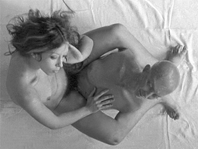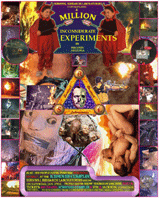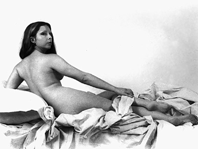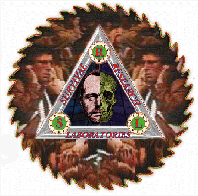|
Heterogénesis
|
|
Nr.
44 - Juli 2003
Arte con carne nr 2 |
 |
Nr
44 - Juli 2003
Arte con carne nr 2 |
|
Biotecnología y arte Staffan Persson |
Biotechnology
and art
Staffan Persson |
Orlan omfamnad av sig själv, 1964
imagen manipulada/manipulerad bild, 50 cm x 60 cm
|
Las últimas décadas han procedido al núcleo de los sistemas de la vida, lo más profundo de la carne, y ha tocado las preguntas sobre las cuales todos hemos ponderado: el misterio de vida y muerte. Obviamente estoy hablando sobre la era genómica, o más explícito sobre la información que está escondida dentro de nuestros hilos crespos de DNA. Los últimos diez años han generado información completa sobre las secuencias genómicas de las moscas, los ratones, el ser humano, la levadura, la planta Arabidopsis y una cantidad de organismos simples. La comunidad investigadora científica está corrientemente utilizando las ventajas ganadas por estos proyectos, pero la información también aumentará la distancia entre el público y los expertos. Este hendido no es probable de ser conectado por las interacciones via la media, que propiamente tiende a crear actitudes hostiles contra la ciencia, y frustración dentro de la area científica por ser mal entendida. Por eso es interesante como científico encontrar varios aspectos de acercamiento biotecnologicos dentro de áreas relacionadas con arte. Desfiguraciones y transformaciones de organismos vivos han sido usado completamente por la historia del arte. Uno de los pioneros en crear híbridos demónicos era el pintor pre-renacentista Hironymus Bosch. Pintando sus creaturas, también puso en la tela lo que la comunidad agronómica se estaba esforzando para lograr: generar híbridos de especies cercanas para, optimistamente, aumentar la potencia y vigor de cosechas o animales. La técnica de elección era un acercamiento biotecnológico crudo, donde los genomes de dos especies se mezclaban via unión sexual a nuevas unidades genómicas. La progenitura luego era investigada buscando los rasgos de interés. La lucha por un mejoramiento en potencia y nutrición también es un elemento importante para los investigadores biotecnológicos modernos más exquisitos. Además, preguntas fundamentales de como controlar y cambiar redes dentro de organismos se están resolviendo. Varios de estos aspectos también están penetrando distintas áreas de la comu-nidad artística. Este artículo dará ejemplos de puntos de intersección entre la ciencia y el arte enfocando cambios externos e internos del sistema de vida. Errores genéticos pueden arrojar reflexiones graves sobre la aparencia física y comportamientos, a los cuales se refiere como fenotipos de organismos vivos. Para adquirir información sobre qué gene(s) afectan rasgos específicos, los científicos están tratando de liarlos con posiciones genómicas distinguidas. Esta información será potencialmente usada para curar pacientes por la via de propósitos biotecnológicos de, por ejemplo, enfermedades heredadas genéticamente. El interés por mutaciones físicas no es solamente evidente dentro del area científica. Una cariñosa fascinación por deformidades es ciertamente reflexionada en el previo Freak-show Vaudevilles, y también funciona como influencia a artistas como Jake y Dinos Chapman, Cindy Sherman y Joel-Peter Witkin. Los hermanos Chapman producen mutantes fusionando distintas partes del cuerpo, o cuerpos enteros, manequies, resultando en gemelos Siameses de plástico. Las esculturas usualmente son suministradas con cavidades corporales y falos salientes, creando un toque de erótica fría a las esculturas normalmente asexuales. Similarmente, Cindy Sherman, que principalmente expone sus mecanismos de partes de muñecas a través de fotografías, también explora cuestiones eróticas y pornográficas a través de su trabajo. Ambos trabajos de los artistas están penetrados por explotaciones del cuerpo humano, no solamente enfocando cuestiones pornográficas, sino también retratando “la mentalidad del cuerpo perfecto” constantemente presente en nuestra sociedad. Sin embargo, la aparencia de estas creaciones está últimamente liada a procesos que toman lugar dentro de los cuerpos, es decir su contenido genético. Otros aspectos de cambio físico están dentro del tiempo. Evolución, que es el reloj que los científicos están tratando de reponer o apurar, está constantemente rearreglando varios componentes en nuestro genoma, dependiendo de las condiciones que organismos estén esperimentando. Distorciones evolutivas han sido exploradas por el artista Daniel Lee, fundiendo funciones de animal y humano en forma de animaciones de computadora. Las cadenas evolutivas sugeridas en a través de su trabajo, podrían ser imaginadas como reconstrucciones arqueológicas de algo viable pero no extinguido. Interesantemente, la mezcla entre humano y animal también funciona como una recordación de nuestra relacion cercana , que más definitivamente esta probada por las similtudes entre los humanos y los chimpancés. El trabajo de Daniel Lee por lo tanto lía criaturas compuestas de artistas como Bosch y Max Ernst, con aspectos de evolución molecular. Como lo mencionado antes, las maneras de modificar sistemas vivos genéticamente hasta hace poco han sido bastante crudas. Aun más, las últimas décadas han generado otros métodos de modificación corporales: las armas de la cirugía plástica. Los medios se han asegurado de que el público constantemente esté enterado que Michael Jackson se ha transformado, y que el cuerpo humano puede ser remodelado a aparencias más atractivas. Con el intercambio de pinceles y pintura a escalpelos y silicona, el artista Orlan ha iniciado un movimiento de arte al cual se refiere como Carnal Art (Arte Carnal). Interesantemente, Orlan une la escultura clásica con métodos cirujanos, trasformándose en figuras mitológicas tallando su propia carne. Este concepto proyecta al artista como la materia prima para ser remodelada, y definitivamente la pone en relación íntima con su arte. Acciones similares han sido hechas por el artista Sudafricano Bruce Louden, que se corta parte por parte su cuerpo. Finalmente, estas acciones son tanto sobre el control y domesticación de las fuerzas de la naturaleza, como una respuesta a obsesiones corporales. Analogamente, la lucha por ganarle a la naturaleza, o por lo menos ser capaz de controlarla y entenderla, conduce ciertos aspectos de la comunidad de investigación. Esto está reflejado en la corriente lucha de evaluar y vencer el virus SARS, que se está extendiendo establemente por China. La lucha para controlar también es evidente en varios actos del grupo Survival Research Laboratories (SRL) (Laboratiorios de Investicación de Supervivencia) en San Francisco. SRL contruye aparatos de un nivel meáanico altamente avanzado mezclados con materia orgánica, controlados por un control remoto. Los aparatos están a menudo construidos en forma de criaturas, que son expuestas a examinaciones o competiciones entre si. Las criaturas pueden, por supuesto, ser vistas en un contexto de ciertos aspectos mecánicos dentro de la comunidad científica. Investigadores pueden reconstruir aspectos de procesos que ocurren naturalmente, que subsiguientemente pueden ser usados para concentrarse selectivamente en funciones claras. Un ejemplo está en la introducción de genes nuevos a plantas, o a lo que referimos como modificación genética de plantas. En este caso una bacteria que existe en la naturaleza, que puede cortar y pegar partes de su propio DNA a la planta genome, ha sido modificada para que introduzca selectivamente genes de interés a una planta. Aunque la modificación de cuerpos que ha sido escrita hasta ahora son intervenciones externas, la útlima frase provee carburante para acciones dentro del cuerpo. Por consecuencia la última parte del texto enfocará los productos fusionados arte-biotecnología. Aún cuando la exactitud de la inserción de genes ha aumentado, y los procedimientos han llegado a ser más simples, los métodos biotécnicos han sido usados en áreas fuera de la ciencia. Uno de los casos más conocidos es el del conejo verde, creado por el artista Brasilero Edardo Kac. Introduciendo un gen de una medusa, codificando para una proteina que fluoresce en verde, Kac incorporó herramientas explícitamente biotécnicas al área del arte. Otro artista que ha modificado organismos genéticamente es el artista británico Heath Bunting. Bunting construyó una bolsa, que potencialmente podría ser usada para hacer lo que el nombra super-maleza. Introduciendo un gen que codifica una proteina a la maleza que es resistente a los pesticidas, Butning quiere provocar un debate intenso sobre empresas dentro del área genética. Para encontrar más información sobre su trabajo lo puede contactar por mail que aparece en la siguente información: P:
¿Adónde aprendiste las técnicas para ejecutar,
por ejemplo, transformaciones de plantas? En
vista de la histeria terrorista, el trabajo de Bunting es obviamente
muy provocativo y puede que conmueva debates sobre el riesgo potencial
de amenazas terroristas. Por otro lado, su trabajo también presenta
aspectos espirituales de biotecnologia. La creación y el control
preciso de la vida está a la vuelta de la esquina, una esquina
la cual sólo Dios ha doblado antes de nosotros. Fanáticos
religiosos han por eso levantado sus voces para por ejemplo parar la
investigación de la célula de tallo, y en varios países
han sido exitosos. Sin embargo, descubrimientos científicos por
la historia han demostrado que las prohibiciones religiosas serán
vencidas con el tiempo. Bunting mantiene corrientemente una mano activa
dentro de esta área y ahora está creando un virus transportado
via aerosol que potencialmente podría matar las plantas modificadas
genéticamente. Este projecto ciertamente provocará más
debates dentro del area. |
The last decades have descended into the core of the living systems, the innermost of the flesh, and have touched upon the questions we all have pondered upon: the mystery of life and death. I am of course talking about the genomic era, or more explicit about the information that is hidden within our curling DNA strands. The last ten years have generated complete information about the genomic sequences of the fruit fly, mouse, human, yeast, the plant Arabidopsis and numerous simpler organisms. The scientific research community is currently utilizing the advantages gained through these projects, but the information will also increase the distance between the public and the experts. This widening cleft is not likely to be bridged by the interactions through media, which rather tends to create hostile attitudes towards science, and frustration within the scientific area for being misunderstood. As a scientist it is therefore interesting to find various aspects of biotechnological approaches within art-related areas. Disfigurements
and transformations of living organisms have been used thoroughly throughout
art history. One of the pioneers in creating demonic hybrids was the
pre-renaissance painter Hieronymus Bosch. Depicting his creatures, he
also put on canvas what the agronomical community was striving for:
generating hybrids of closely related species to, hopefully, increase
yield and hardiness of crops or animals. The technique of choice was
a crude biotechnological approach, where the genomes from two species
were merged through sexual mating into new genomic entities. The off-springs
were then investigated for traits of interest. The struggle for yield
and nutrient improvements are also key elements for the more exquisite
modern-day biotechnological researcher. In addition, fundamental questions
of how to control and change complex networks within organisms are being
solved. Several of these aspects are also permeating different areas
of the artistic community. This article will give examples of intersecting
points of science and art with focus on both external and internal changes
of living systems. Other aspects of physical changes lies within time. Evolution, which is the clock scientists are trying to reset or speed-up, is constantly rearranging various components in our genome, depending on the conditions that organisms are experiencing. Evolutionary distortions have been explored by the artist Daniel Lee, fusing animal and human features in the form of computer animations. The evolutionary chains suggested through his work, could be imagined as archaeological reconstructions of something once viable but now extinct. Interestingly, the mixture of human and animal also works as a reminder of our close relationship, which most definitively is proven by the genetic similarities between humans and chimpanzees. Daniel Lee’s work therefore links creatures composed of artists like Bosch and Max Ernst, with aspects of molecular evolution. As mentioned above, the ways to modify living systems genetically have until recently been rather crude. In addition, the last decades have generated other methods for bodily modifications: the weapons of plastic surgery. Media have made certain that the public constantly are aware of what Michael Jackson has transformed into, and that the human body can be remodelled into more attractive appearances. With the exchange of brushes and paint for scalpels and silicon, the artist Orlan has initiated an art movement which she refers to as Carnal Art. Interestingly, Orlan bridges classical sculpting and surgical methods, transforming herself into mythological figures by carving her own flesh. This concept projects the artist as the raw material to be remodelled, and definitively puts her into an intimate relation to her art. Similar actions have been done by the South-African artist Bruce Louden, who cuts of part after part of his body. Ultimately, these actions are as much about controlling and domesticating natural forces, as a response to bodily obsessions. Analogous, the struggle to beat nature, or at least to be able to control and understand it, drives certain aspects of the research community. This is reflected in the current struggle to evaluate and knock-out the SARS virus, steadily spreading throughout China. The struggle for control is also evident in various acts of the San Fransisco based group Survival Research Laboratories (SRL). SRL constructs highly advanced mechanical devices blended with organic matter, controlled by remotes. The devices are often constructed in the form of creatures, which are run through various tests or competitions against each others. The creatures can, of course, be viewed in context to certain mechanistic aspects within the scientific community. Researchers can reconstruct aspects of naturally occurring processes, which subsequently can be used to selectively target distinct functions. One example lies within the introduction of new genes into plants, or what we refer to as genetically modifications of plants. In this case a naturally occurring bacteria, which can cut and paste regions of its own DNA into the plant genome, has been modified to selectively introduce genes of interest into a plant. Although the modifications of bodies described so far are mediated externally, the last sentence provides fuel for actions from within the body. Consequently the last part of the text will focus on the merged art-biotechnology products. As the accuracy of gene insertions have increased, and the procedures have become simpler, biotechnological methods have become utilized in areas outside science. One of the more recognized case is the green rabbit, made by the Brazilian artist Eduardo Kac. By introducing a gene from a jelly-fish, encoding for a protein that fluoresces in green, Kac incorporated explicit biotechnological tools into the art area. Another artist that has modified organisms genetically is the British artist Heath Bunting. Bunting has constructed a kit, which potentially could be used to make what he refers to as super-weed. Introducing a gene which encodes for a protein involved in pesticide resistance into the weed, Bunting wants to provoke an intensified debate on companies within the genetic field. To find out additional information about his work I contacted him via email which resulted in the following information Q:
Where did you learn the techniques to perform, for example, transformations
of plants? In view of the terrorist hysteria, Bunting’s work is of course very provocative and may stir up debates about the potential risks of terror threats. On the other hand, his work also presents spiritual aspects of biotechnology. The creation, and the precise control, of life lays around the corner, a corner of which only God has turned before us. Religious fanatics have therefore raised their voices to put a stop to for example stem cell research, and have in several countries been successful. Still, scientific discoveries throughout history has proved that religious bans will eventually be overcome. Bunting is currently maintaining an active hand within this area and is now creating a aerosol-transported virus which potentially could kill off the genetically modified plants. This project will certainly stir up more debates within the field. |
 |
 |
 |
|
Survival
Research
Laboratories’/ SRL:s Logotype |
Orlan:
La Grande Odalisque/ La Gran Odalisca, 1968. 30 x 40 cm |
SRL:
A Million Inconsiderate
Experiments Poster, Phoenix, AZ 1996 |
| Staffan
es estudiante de doctorado en el Departamenteo de Bioquímica de
Plantas en la Universidad de Lund, Suecia. También es uno de los
fundadores del grupo performático “The Centre for Transgressive
Behaviours” (CTB), (El Centro de Conductas Transgresivas). Email: staffan.person@plantbio.lu.se Heath Bunting puede ser contactado vía su mail: heath@irational.org |
Staffan
is a PhD student at the Plant Biochemistry Dept at Lund University, Sweden.
He is also one of the founders of the performance group “The Centre
for Transgressive Behaviors” (CTB). Email: staffan.person@plantbio.lu.se Heath Bunting can be reached through email at: heath@irational.or |

